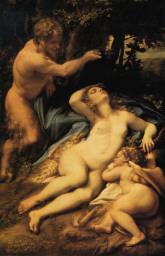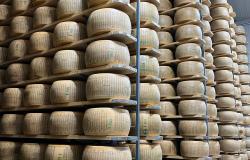Parma is celebrating the genius of one of its most talented artists, Antonio Allegri da Correggio (1489-1534), offering visitors the chance to see some of his greatest masterpieces in their natural surroundings.
An exhibition opening September 20 will not only showcase his freestanding paintings and drawings, it will also encompass his three most important frescos in situ.
The event will give visitors the unique opportunity to admire his frescos up close and in detail, thanks to a system of lifts and scaffolding set up for the duration of the exhibit.
The Convent of St Paul houses a fresco featuring an arbour and cherubs, which decorated the ceiling of what was once the dining room of the Mother Superior.
Completed in 1519, this was followed the next year by a scene of St. John on Patmos for the dome of the Church of San Giovanni Evangelista.
The third work is a 1524 fresco on the dome of the Cathedral of Parma, showing a dramatic, layered scene of the Assumption of the Virgin.
The latter two works in particular are considered emblematic of Correggio's skill with illusion and perspective, which influenced the work of dozens of future fresco artists.
Despite achieving widespread recognition in his own day, Correggio's work was often overlooked in favour of his contemporaries by later generations.
Critics say this neglect has little to do with Correggio's skill and much to do with the fact he never worked in Rome - a de rigueur rite of passage for artists that gave them the chance to rub shoulders with rich patrons and contribute to masterpieces at major sites.
Instead, the artist spent most of his adult life in Parma, and the vast majority of his works, particularly his frescoes, are now located in either Parma, Modena or Correggio, the small town where he was born not far from Reggio Emilia.
However, Correggio's name has enjoyed a resurgence of interest in recent years and he is now considered one of the most skilled, innovative and lively 16th-century artists, drawing particular praise for his use of illusionistic perspective and foreshortening.
The exhibit at the Parma National Gallery is the second major event this year devoted to Correggio and already looks set to be a hit, with 30,000 advance bookings.
It opens just four days after the end of a popular exhibit in Rome's Galleria Borghese, and, although much larger, features a number of the same paintings.
The Parma show counts around 80 movable works by Correggio, divided equally between paintings and drawings, as well as around 40 pieces by his contemporaries, helping provide context.
The selection includes a number of his paintings inspired by the myths and patterns of Ancient Rome, as well as focusing on more conventional religious subjects.
Most of his mythological works, including a famous rendering of Danae being impregnated by golden rain, are from a renowned set depicting scenes from Ovid's Metamorphoses, exploring the amorous adventures of Jupiter.
Although commissioned by Federico II Gonzaga of Mantua to decorate one of his own rooms, the ruler gave the series away to the visiting Holy Roman Emperor Charles V, who took them from Italy not long after.
The Kunsthistoriches in Vienna has loaned two of its paintings, Jove And Io, and Ganymdede Abducted By The Eagle.
Another two works, depicting Cupid and his mother Venus, are being provided by London's National Gallery (The Education of Cupid) and the Louvre in Paris (Venus and Cupid with a Satyr).
The selected religious works also highlight Correggio's links with the classical past through his formal and compositional decisions, despite the more conventional subject matter.
The Brera in Milan has loaned its Adoration of the Magi, Noli Me Tangere will arrive from the Prado in Madrid, while New York's Metropolitan Museum of Art will send its Four Saints.
The Mystic Marriage of St. Catherine, usually kept in Naples' Capodimonte Museum, will also be on display. One of artist's best-loved paintings, a vibrant, glowing family scene, it clearly shows Leonardo da Vinci's influence on Correggio's early work.
The exhibit in Parma's National Gallery, entitled simply ''Correggio'', runs from September 20 until January 25.



